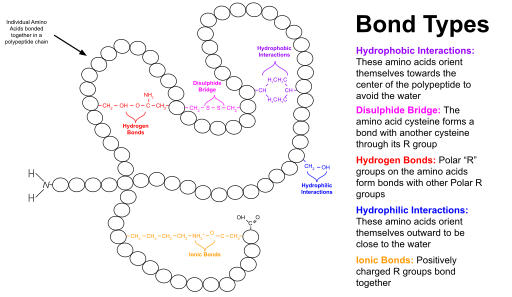
Back بنية بروتين ثالثية Arabic Tercijarna struktura proteina BS Estructura terciària de les proteïnes Catalan Tertiärstruktur German Τριτοταγής δομή πρωτεΐνης Greek Terciara strukturo Esperanto Estructura terciaria de las proteínas Spanish Structure tertiaire French Estrutura terciaria das proteínas Galician מבנה שלישוני HE
This article needs additional citations for verification. (December 2013) |



Protein tertiary structure is the three-dimensional shape of a protein. The tertiary structure will have a single polypeptide chain "backbone" with one or more protein secondary structures, the protein domains. Amino acid side chains and the backbone may interact and bond in a number of ways. The interactions and bonds of side chains within a particular protein determine its tertiary structure. The protein tertiary structure is defined by its atomic coordinates. These coordinates may refer either to a protein domain or to the entire tertiary structure.[1][2] A number of these structures may bind to each other, forming a quaternary structure.[3]
- ^ IUPAC, Compendium of Chemical Terminology, 2nd ed. (the "Gold Book") (1997). Online corrected version: (2006–) "tertiary structure". doi:10.1351/goldbook.T06282
- ^ Branden C. and Tooze J. "Introduction to Protein Structure" Garland Publishing, New York. 1990 and 1991.
- ^ Kyte, J. "Structure in Protein Chemistry." Garland Publishing, New York. 1995. ISBN 0-8153-1701-8
© MMXXIII Rich X Search. We shall prevail. All rights reserved. Rich X Search